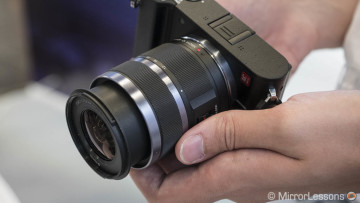It is not uncommon to see the Micro Four Thirds mount being used by smaller companies to create digital imaging products. The latest to adopt the system is YI (Young Innovators), a Chinese company that released their first entry-level mirrorless camera, the YI M1, just in time for Photokina 2016.
It has a competitive price, a simple interface that relies mostly on the 3-inch touch screen, 4K video and the Sony 20MP sensor used for the Lumix GX8. You will find all the information about the YI M1 in our hands-on video below, followed as usual by a summary of our thoughts, as well as some product and sample images.
Our first impressions in a nutshell:
- The camera is made of plastic and YI says it is scratch-resistant. It feels very light. The two lenses have a plastic mount.
- No tilting screen but there is touch sensitivity. The camera has just 4 buttons, leaving most of the operations to the touch screen. You swipe to the right to enter the menu, or to the left to select the picture profile or other options depending on the shooting mode selected. The menu is easy to navigate and the touch screen is responsive and precise most of the time.
- To change aperture or shutter speed, you must first touch the dedicated symbol on the left side of the screen, then rotate the command dial on top. YI says they integrated a physical dial for those who prefer it to a touch screen but you still need the latter to perform the operation.
- The M1 has the same 20MP sensor found inside the Panasonic GX8 and Olympus Pen F. You get the same ISO sensitivity (200 to 25600) but the processor engine is of course different. The M1 has a 50MP mode that is the result of interpolation (the 20MP image is upscaled to 50MP in camera). Judging by the few shots I was able to take, the JPGs are a little soft. I am curious to see the quality of the RAW file and test how effective the 50MP mode can be.

- The autofocus system has 81 points and comes with contrast detection. You get face detection and you can use the touch screen to select a focus point or take a shot. You can choose between a Multi and Single AF area. The AF wasn’t slow but not very fast either in comparison to the most recent Lumix and Olympus cameras. Continuous shooting goes up to 5fps.
- The camera can record in Full HD, 2K and 4K format at 30fps. The 4K footage seemed good to me but there seem to be lots of jello effects which is due to rolling shutter. The camera switches to Continuous AF automatically when you hit the record button: it fairly reactive but tends to hunt back and forth too much even when the subject is still.
- A curious feature introduced on this camera is called Master Guide: you select a portrait template and the camera displays an overaly on the LCD screen to help you to pose your subject better and improve the composition. It is meant for beginners, who are the target market of this camera. The idea is not bad and encourages more interaction between the photographer and the subject. In this mode, the camera sets the exposure and AF automatically by detecting the subject.
- The two lenses announced with the camera are the XIAOYI 12-40mm f/3.5-5.6 and XIAOYI 42.5mm f/1.8. The latter has a semi macro mode and can focus as close as 25cm. They lack optical stabilisation and the M1 doesn’t feature any sensor or digital stabilisation.

- The camera is compatible with all Micro Four Thirds lenses. I took a few shots with the Lumix G 35-100mm f/2.8 and the AF seemed fast and responsive.
- Finally, it has Wifi and Bluetooth connectivity.
Several articles on the web shared an attractive price of around $300 dollars but the official prices tell a different story. You can get the camera for almost $500 with the 12-40mm, $600 with the 42.5mm and $700 with the two lenses.
While these prices remain very competitive, I have to say that you can find other mirrorless cameras from Lumix and Olympus at a similar price, if not for even less, such as for example the Lumix GF7 or OM-D E-M10.

YI told us that the goal with this camera is to bridge the gap between smartphones and mirrorless cameras with something not overly expensive and designed for beginners. They also hope to attract the young generation.
Personally I think it is a good idea but the camera lacks a few things that could appeal to young people like a tilting screen for example. What’s more, the price might still be too high for a teenager who may not want to spend all that money on a camera. But let’s not forget that the camera has just been announced and could come down in price quite quickly in the near future.
Note: our Photokina 2016 coverage can be found here.






